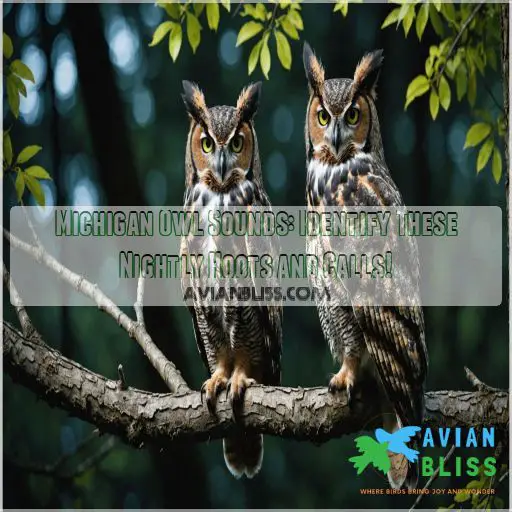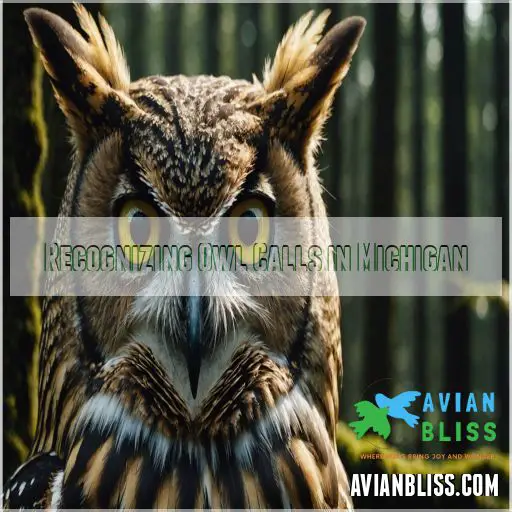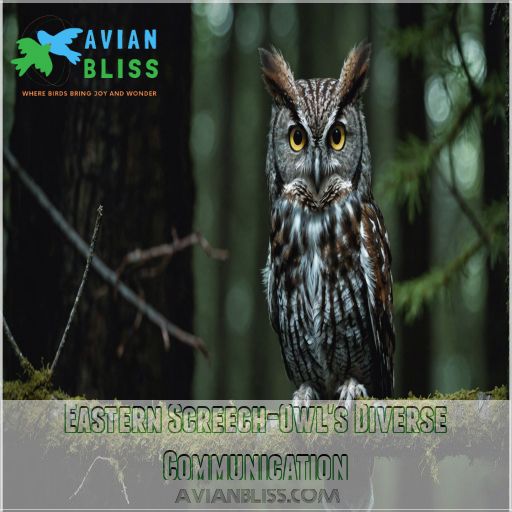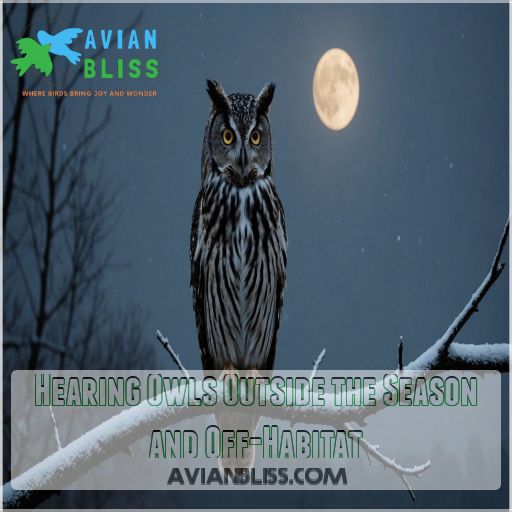This site is supported by our readers. We may earn a commission, at no cost to you, if you purchase through links.

Have you ever heard the noble Great Horned Owl’s “hoo-hoo” or the Barred Owl’s iconic “Who cooks for YOU?” echo through the woods?
Don’t be fooled by the Northern Saw-whet Owl’s adorable look—its “toot, toot” call can be persistent!
Eastern Screech-Owls communicate with interesting trills and whinnies, adapting to city life like pros.
Just remember, while winter birdwatching is exhilarating, it’s as chilly as a polar bear’s picnic!
Ready to uncover more nocturnal secrets from Michigan’s wise and whimsical night owls?
Table Of Contents
- Key Takeaways
- Common Michigan Owl Species
- Recognizing Owl Calls in Michigan
- Eastern Screech-Owl’s Diverse Communication
- Important Winter Periods for Michigan Owls
- Hearing Owls Outside the Season and Off-Habitat
- Frequently Asked Questions (FAQs)
- What kind of owls hoot in Michigan?
- Which owl makes a hoo hoo sound?
- Which owl hoots three times?
- What do different owl sounds mean?
- What is the lifespan of Michigan owls?
- How do owls influence Michigans ecosystem?
- Why are owl populations declining in Michigan?
- What conservation efforts exist for Michigan owls?
- Can owls adapt to Michigan urban environments?
- Conclusion
Key Takeaways
- You’re in for a treat when you tune into Michigan’s owl symphony. The Great Horned Owl‘s "hoo-hoo" and the Barred Owl’s "Who cooks for you?" are like familiar friends in the night, welcoming you into their world. Picture it: moonlit forests filled with mysterious melodies.
- Don’t underestimate the tiny Northern Saw-whet Owl with its relentless "toot, toot" or the Eastern Screech-Owl’s wild trills and whinnies. These little guys pack a vocal punch, proving size doesn’t matter in the animal kingdom’s version of American Idol.
- Winter birdwatching can be as refreshing as a polar bear’s picnic, but prepare for icy roads and chilly toes. Find spots like the whitefish point Bird Observatory for prime listening experiences, but always balance the thrill with safety.
- Owls play a pivotal role in Michigan’s ecosystem, managing rodent populations like nature’s janitors. Keep them thriving by supporting conservation efforts to combat habitat loss and urbanization. They’ll appreciate your help, even if they never say so.
Common Michigan Owl Species
Michigan is home to a diverse array of owl species, each with its own unique calls and adaptations.
From the iconic great horned owl to the diminutive Northern Saw-whet Owl, learning to identify these nocturnal predators by sound can open up a whole new world of birdwatching.
Great Horned Owl and Its Adaptability
The great horned owl is an unparalleled urban adapter.
Its habitat flexibility lets it flourish in Michigan’s suburbs.
With a diverse diet of rabbits, rodents, and sometimes skunks, it’s a relentless hunter with a signature “hoo-hoo” call.
Despite their adaptability, conservation challenges loom, so understanding these owl calls can play a key role in owl identification and protection.
Barn Owl’s Global Distribution and Habitat
Great Horned Owls aren’t the only adaptable ones. Barn owls boast a cosmopolitan passport, calling every continent except Antarctica home. You might spy them nesting in Michigan’s barns or countryside, chasing after mice.
Barn owls face threats despite their global presence. Vulnerable to car collisions and habitat shrinkage, they are threatened by human activity.
Remember their chilling screech—a ghostly serenade—echoes in our minds.
Northern Saw-whet Owl’s Unique Sound
Barn Owls may be global nomads, but Northern Saw-whet Owls bring a symphony to Michigan’s nights.
Imagine a mini percussionist, their "toot, toot" call echoing like a backup truck in a cozy conifer forest.
- Saw-whet call variations: Whines, squeaks, and whistling.
- Mimicry of sounds: Nature’s imitators.
- Owl sound recordings: Capture bird vocalizations.
- Unique call purpose: Attracts mates and marks territory.
Barred Owl’s Expansion and Distinct Call
Chances are you’ve heard the distinctive "Who cooks for YOU?" call of the Barred Owl echoing through Michigan’s forests.
These adaptable birds are expanding their range, now found across the eastern U.S. and even competing with the threatened Northern Spotted Owl out west.
Listen for their hoots and screeches – they’re more vocal than you might think!
Recognizing Owl Calls in Michigan
Recognizing owl calls in Michigan is like tuning into nature’s nighttime symphony, where each species sings with its own unique flair.
While the Barred Owl’s call might sound like they’re asking, "Who cooks for YOU?", the Eastern Screech-Owl’s trill and the Northern Saw-whet Owl’s "toot" create a delightful chorus that makes winter nights anything but dreary. Check out the Eastern Screech-Owl’s call.
The Distinctive Sounds of Barred and Eastern Screech-Owls
Get ready to explore Michigan’s owl world, where the Barred Owl’s "Who cooks for YOU?" rings through the trees.
Meanwhile, the Eastern Screech-Owl’s vocal range offers unique variations:
- Whinny Descend: Rival territory defense.
- Song of Trill: Enticing mates.
- Mimic Mastery: Adapts to urban life.
- Calls Connect: Bridging bird species and humans.
Listen closely, and you’ll uncover a hidden dialogue.
Northern Saw-whet Owl’s Repertoire and Song Patterns
Listening for the Northern Saw-whet Owl can feel like chasing whispers in a winter wonderland.
Their "toot, toot, toot" calls punctuate chilly nights, signaling winter mating rituals.
Don’t let their size fool you; these tiny owls pack vocal punch, blending nocturnal songs and call variations.
Imagine northern ecosystems echoing with mimicry—sometimes sounding like their cousins, the northern hawk-owl and boreal owl.
Differentiating Great Horned Owl and Barred Owl Calls
Two of Michigan’s most iconic owls, the Great Horned and Barred, share overlapping habitats and can be tricky to tell apart.
However, their distinct vocalizations offer a reliable way to differentiate them.
The Great Horned’s deep, resonant hoots contrast sharply with the Barred Owl’s iconic "who cooks for you?" call.
Timing is key too – Barred Owls are more vocal during the day.
What Other Michigan Owls Can I Expect to Hear
You’ve already got a handle on the Great Horned and Barred Owl calls.
So, what other Michigan owls can sing to your senses?
Eastern Screech-Owl’s trills and whinnies add pizzazz.
Discover the Northern Saw-whet’s “toot, toot” symphony.
You might even spot a snowy or burrowing owl around the Great Lakes or at Whitefish Point and Seney Wildlife Refuge.
Eastern Screech-Owl’s Diverse Communication
In Michigan, the eastern screech-owl can intrigue you with its diverse calls, ranging from a territorial whinny to a mating trill.
As you listen, you’ll discover that these owls adapt their calls depending on the environment, much like how people switch their tone when chatting with an adult versus a toddler.
Two Main Calls and Their Meaning
In Michigan, recognizing owl calls requires an ear for detail, especially when eastern screech-owls step into the spotlight.
Their call variations—whinnies for territory defense and thrilling trills for mate attraction—echo through the upper peninsula.
Like a tiger owl defending its territory or a "demon owl" warding off threats, these sounds announce their presence with haunting, ghostly melodies.
Call Similarities and Differences Among Regions
The Eastern Screech-Owl’s calls can vary across its wide geographic range.
While the familiar descending whinny and extended trill are heard throughout, subtle regional differences exist.
Owls in the East may have more rufous-colored plumage and a deeper, richer trill compared to their paler, higher-pitched cousins out West.
- Rufous-morph owls more common in the East
- Deeper, richer trill in Eastern populations
- Higher-pitched calls in Western birds
- Geographic variation in call pitch and quality
- Subtle regional dialects across the species’ range
Calling Strategies in Response to Different Environments
Think of the Eastern Screech-Owl’s calls like a band with different tunes for different venues.
Call variations reflect habitat influence: urban adaptation might mean softer calls to avoid attention or predator response.
Seasonal changes tweak their playlist, intensifying during mating season.
Much like us, their environment shapes their communication choices – always telling the right story at the right moment.
Important Winter Periods for Michigan Owls
When winter grips Michigan, it’s the prime time for listening to the mysterious calls of its varied owl species.
You’ll find the best spots unhindered by snow and traffic, but watch out for that wintry charm wearing thin in the later months as you navigate the challenges of the season.
Optimal Winter Viewing Spots and Techniques
Winter birdwatching in Michigan‘s serene wilderness holds a certain magic.
Unearth grandeur in these owl hotspots:
- Whitefish Point Bird Observatory: A must for eagle-eyed enthusiasts.
- Coniferous forests of the Upper Peninsula: Offers sanctuary for rare sightings.
- Local parks with dense trees: Embrace nature on a chilly night.
For expert owl watching tips, keep your distance and respect their habitat.
Disadvantages and Hazards in Late Season Winter Observation
Sadly, late-season winter observation poses several disadvantages and hazards. Frigid temperatures, icy roads, and unpredictable weather can make travel treacherous. Prolonged exposure may also stress owls, disrupting their natural behaviors. Consider these risks:
| Hazard | Impact |
|---|---|
| Extreme Cold | Hypothermia, frostbite |
| Slippery Conditions | Increased accident risk |
| Owl Disturbance | Nest abandonment, reduced hunting success |
| Poor Visibility | Missed sightings, safety concerns |
Weigh the rewards against the risks, and plan accordingly for a safe, responsible experience.
Critical Early Period in March During Varying Season Length
In March, as daylight stretches, Michigan owls commence early breeding.
You might hear owls nesting and claiming territories in this fluctuating season length.
It’s as if nature’s orchestra tunes its instruments for the springtime symphony.
Owl migration paths shift, offering you a magical opportunity to witness these majestic creatures orchestrating their lives amidst the changing seasons.
Hearing Owls Outside the Season and Off-Habitat
Even outside traditional seasons and habitats, you might catch the unexpected call of a wandering owl looking for new territory or a snack.
It’s like stumbling upon a hummingbird in your snow boots—rare but enchanting, so keep those ears (and maybe a snow hat) on alert!
Migration Calendar Details
Though owls are typically winter wonders, understanding owl migration patterns is key to hearing them year-round. Immerse yourself in the geeky details of their travel dance:
- Timing of arrival aligns with climate changes.
- Departure dates vary, so keep your ears open.
- Migration routes often surprise.
- Seasonal variation keeps you guessing.
- Unexpected hoots spice up your nights!
Audubon Account Application and Current System Availability
The Audubon app is a handy tool, but you may run into login troubles or system glitches.
Don’t fret – their support team is here to help.
Just renew your membership, and you’ll be back on track to identify those elusive owls, even when they’re off-season or off-habitat.
The app’s features make it a breeze to track their calls.
Frequently Asked Questions (FAQs)
What kind of owls hoot in Michigan?
You’ll hear the iconic hoots of the Great Horned Owl echoing through Michigan’s forests year-round.
These adaptable raptors thrive in diverse habitats, from wooded areas to suburban neighborhoods.
Keep an ear out for their distinctive calls!
Which owl makes a hoo hoo sound?
In Michigan, the Great Horned Owl serenades the night with its classic "hoo hoo" sound.
It’s like nature’s baritone vocalist, setting the mood as you imagine hiking in a moonlit forest.
So magical!
Which owl hoots three times?
You might think the owl’s an ancient librarian, quietly hooting "Whoooo cooks for you?" three times from the treetops.
That’s the Barred Owl, a nocturnal chatterbox with a call that’s as memorable as a catchy tune.
What do different owl sounds mean?
Owl sounds are nature’s secret code: hoots claim territory, screeches warn of danger, and soft trills are love notes echoing through the night.
Each sound carries a message, offering a glimpse into these mysterious creatures’ world .
What is the lifespan of Michigan owls?
Curious critters, Michigan’s owls can soar skyward for over a decade! These winged wonders boast lifespans ranging from 8 to 15 years, showcasing their resilience in the Great Lakes State’s diverse habitats.
How do owls influence Michigans ecosystem?
In Michigan’s ecosystem, owls act like nature’s janitors, keeping the rodent population in check.
These stealthy hunters help maintain a balanced food chain, quietly orchestrating their role from the shadows, making forests lively yet safe havens.
Why are owl populations declining in Michigan?
In Michigan, owl populations are declining due to habitat loss, vehicle collisions, and pesticide use.
Urbanization has disrupted their natural habitats, and roads are literal death traps.
Protecting these magnificent creatures requires smart conservation efforts and mindful urban planning.
What conservation efforts exist for Michigan owls?
Guardians of the night sky, owls in Michigan need your help to learn more about owls in Michigan!
Support habitat restoration projects, minimize pesticide use, and engage with local conservation organizations.
By safeguarding their homes, you’re ensuring these wise predators continue their haunting serenades.
Can owls adapt to Michigan urban environments?
Many Michigan owls, like the Eastern Screech-Owl, have adapted remarkably well to urban environments.
They thrive in parks, neighborhoods, and even city centers, taking advantage of the abundant food sources and nesting sites.
Conclusion
Like a well-rehearsed orchestra, Michigan owl sounds create a melodious night symphony that enchants and educates.
By learning these calls, you can engage deeply with nocturnal birds.
Recognize the Great Horned Owl’s majestic hoot and the cute yet persistent call of the Northern Saw-whet Owl.
Winter offers its unique challenges, but observing these fascinating creatures is rewarding.
So grab your binoculars and venture out, ready to identify these elusive, enchanting voices of Michigan.








